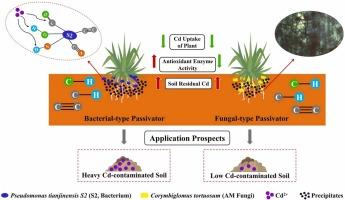新分离的细菌和丛枝菌根真菌能有效降低日本麦冬根部的镉浓度并增加其根部生物量
IF 11.3
1区 环境科学与生态学
Q1 ENGINEERING, ENVIRONMENTAL
引用次数: 0
摘要
土壤镉(Cd)污染是粮食生产中的主要挑战之一。这导致黄参根中镉的积累高于最大阈值。本研究鉴定了新分离的天津假单胞菌S2 (PL)和丛枝菌根真菌Corymbiglomus tortuosum (Ct)是降低粳稻根中Cd浓度的有效药剂。与对照(CK)相比,根系Cd水平分别降低了62.27%和46.13%,显著提高了根系生物量。我们还注意到-OH、-CH和CC官能团在两种处理中都参与了Cd螯合,并且在PL和Ct处理中形成了沉淀物,包括C2H2CdO4、C4H6CdO4、Cd(OH)2和Cd3(PO4)2。此外,与对照相比,PL和Ct处理土壤中残留Cd的比例分别提高了21.21%和10.61%。结果表明,在cd高污染田中,天津p.t jinensis S2比C. tortuosum更有效,而真菌接种剂适用于低污染田中,为生物修复提供了有价值的策略。因此,我们建议进一步研究天津白杨S2和弯叶白杨组合对黄杨根系生长和Cd积累的影响。本文章由计算机程序翻译,如有差异,请以英文原文为准。

Newly isolated bacterium and arbuscular mycorrhizal fungus effectively reduce the root cadmium concentration and increase the root biomass of Ophiopogon japonicus
Soil cadmium (Cd) contamination is one of the major challenges in food production. This has led to above-maximum threshold accumulation of Cd in O. japonicus roots. This research identifies Pseudomonas tianjinensis S2 (PL), a newly isolated bacterium, and Corymbiglomus tortuosum (Ct), an arbuscular mycorrhizal fungus (AMF), as effective agents for reducing Cd concentration in the roots of O. japonicus. Compared to the control (CK) treatment, the root Cd levels decreased by 62.27 % and 46.13 %, respectively, significantly enhancing root biomass. We also noticed the involvement of –OH, –CH, and C![]() C functional groups in Cd chelation in both treatments, and the formation of precipitates, including C2H2CdO4, C4H6CdO4, Cd(OH)2, and Cd3(PO4)2, in both PL and Ct treatments. Moreover, the proportion of residual Cd in soil increased by 21.21 % and 10.61 % for the PL and Ct treatments, respectively, compared to the CK. The findings suggest that P. tianjinensis S2 is more effective than C. tortuosum for high Cd-contaminated fields, while the fungal inoculant is suitable for lower contamination levels, offering valuable strategies for bioremediation. Therefore, we suggest further research to focus on elucidating the effect of a P. tianjinensis S2 and C. tortuosum combination on O. japonicus root growth and Cd accumulation.
C functional groups in Cd chelation in both treatments, and the formation of precipitates, including C2H2CdO4, C4H6CdO4, Cd(OH)2, and Cd3(PO4)2, in both PL and Ct treatments. Moreover, the proportion of residual Cd in soil increased by 21.21 % and 10.61 % for the PL and Ct treatments, respectively, compared to the CK. The findings suggest that P. tianjinensis S2 is more effective than C. tortuosum for high Cd-contaminated fields, while the fungal inoculant is suitable for lower contamination levels, offering valuable strategies for bioremediation. Therefore, we suggest further research to focus on elucidating the effect of a P. tianjinensis S2 and C. tortuosum combination on O. japonicus root growth and Cd accumulation.
求助全文
通过发布文献求助,成功后即可免费获取论文全文。
去求助
来源期刊

Journal of Hazardous Materials
工程技术-工程:环境
CiteScore
25.40
自引率
5.90%
发文量
3059
审稿时长
58 days
期刊介绍:
The Journal of Hazardous Materials serves as a global platform for promoting cutting-edge research in the field of Environmental Science and Engineering. Our publication features a wide range of articles, including full-length research papers, review articles, and perspectives, with the aim of enhancing our understanding of the dangers and risks associated with various materials concerning public health and the environment. It is important to note that the term "environmental contaminants" refers specifically to substances that pose hazardous effects through contamination, while excluding those that do not have such impacts on the environment or human health. Moreover, we emphasize the distinction between wastes and hazardous materials in order to provide further clarity on the scope of the journal. We have a keen interest in exploring specific compounds and microbial agents that have adverse effects on the environment.
 求助内容:
求助内容: 应助结果提醒方式:
应助结果提醒方式:


